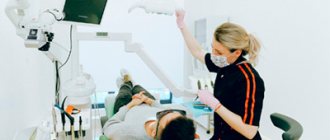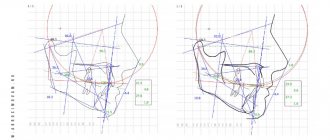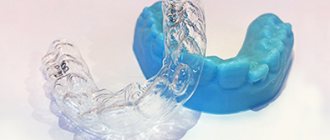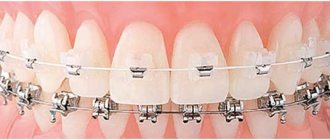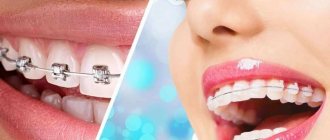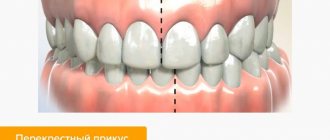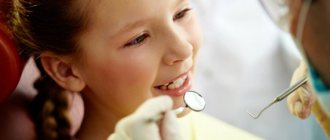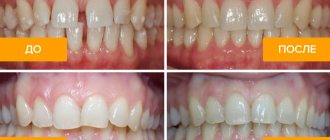An abnormal bite and crooked teeth are not only an anatomically incorrect position of the teeth on the jaw. This is the source of a whole range of problems affecting the health of a number of organs and systems that determine the psychological state of a person. Problems associated with bite are classified as chronic, which is why the patient often does not realize the severity of his condition and does not connect the existing discomfort with the condition of the oral cavity. But in vain.
How is the condition of your teeth related to your overall health?
While a person is young, his body has a significant “margin of safety”, thanks to which many problems are in a state of compensation for a long time. At the level of the oral cavity, the incorrect position of the teeth is compensated by changes in the tone of the masticatory muscles, increasing the load on the joints of the lower jaw and periodontal tissue. With age, teeth that are positioned incorrectly on the jaw begin to wear out and decay faster, increasing the likelihood of developing periodontal disease, their loosening and loss.
Insufficiently thorough chewing of food reduces the efficiency of the digestive system. Crowding and mismatch of the chewing surfaces of the antagonist teeth of the upper and lower jaws contribute to the accumulation of bacterial plaque and the rapid development of caries. Changes in the tone of the facial muscles and incorrect position of the jaws relative to each other have a negative impact on posture. Damage to the temporomandibular joint can cause chronic headaches.
Occlusion and the psychological state of a person
The standard of beauty is perfectly straight white teeth. Depending on how close a person’s smile is to the ideal, the attractiveness of a particular individual to others is determined. You can talk as much as you like about spiritual beauty, but it is often not possible to see it behind its repulsive appearance. Crooked teeth, a significant amount of deposits, and a pronounced decrease in the height of the crowns determine not only the attractiveness, but also the age of the patient. The worse the teeth, the older the person is in the perception of other people.
An unaesthetic appearance of a smile causes difficulties in interpersonal communication, a feeling of embarrassment, awkwardness, and the formation of psychological complexes. At the same time, there is no need to constantly worry about your own imperfections. If previously it was possible to correct a bite only in childhood and adolescence, now there are no restrictions for orthodontic correction. And now there is no need to even wear braces. Aligners can be used on patients of all ages.
Is it possible for adults to straighten teeth without braces?
Contraindications to straightening teeth without braces are minimal. Of the main ones, only three can be distinguished:
- mental disorders
- indiscipline
- poor oral hygiene
People with an upset psyche simply will not be able to wear them, undisciplined people will not do it regularly, and those who do not take care of their teeth first need to attend to the issue of hygiene, and then begin to correct their bite. As for age restrictions, you can straighten crooked teeth without braces from the age of ten to twelve, after the eruption of the first premolars, and there is no upper age limit at all.
Correction of bite with mouth guards
Aligners, also known as transparent aligners made of a polymer transparent biocompatible material, are made for the patient on an individual basis. They fully take into account the anatomical features of the structure of a particular dental system, which makes it possible to effectively eliminate existing disorders. The process of manufacturing aligners is quite labor-intensive, which affects the cost of the products and the time spent on orthodontic correction.
Manufacturing of aligners includes:
- complete sanitation of the oral cavity;
- taking dental impressions;
- making trays from impressions in the laboratory.
The thickness of the aligners does not exceed 1 mm. Thanks to the special properties of the materials, the aligners are not visible on the teeth even at close range, and do not cause glare in the sun or when photographing using a flash.
Trainers
Orthodontic trainers are removable silicone covers for the teeth. They are worn for several hours a day: at night and for 2–4 hours during the day. They are used to correct occlusion in children and in simple situations (for example, when there are gaps between dental elements) in adults.
There are several types of trainers:
- standard for the initial stage of treatment - made of soft pink silicone. This period lasts about six months. The main goal is to influence the position of the jaws and facial muscles;
- standard for the final stage - made from harder blue silicone. They directly influence the movement of teeth in the dental row;
- Lm-activators are trainers, the unique feature of which is that they can be used before all teeth erupt, when the process is just beginning. Their use allows the teeth to settle into place immediately after eruption;
- myobraises – allow for early correction in a natural way, from the age of 3 years. The system does not work on the consequence, but on the causes of the formation of malocclusion. Myobraises are worn for 1 hour during the day and worn throughout the night.
Aligner capabilities
Unlike braces, the capabilities of polymer trays are somewhat limited. However, don't let this bother you. Not all patients of an orthodontist have a malocclusion so serious that they cannot do without braces. In most cases, a softer and gentler effect on the dentition is enough to improve the appearance of the smile area.
What anomalies can aligners treat:
- incorrect position of individual teeth;
- the need to perform extrusion or intrusion of teeth;
- crowding or, conversely, sparse position of teeth on the jaw;
- crossbite;
- unexpressed degree of deep bite.
Mouth guards will not cope with distal or mesial bite, since the development of these anomalies is based on the uneven development of the upper and lower jaws. In fact, this is the only limitation of the technique.
Is it always possible to straighten teeth without braces?
Remember: the success of treatment, first of all, depends not on the orthodontic device, but on the doctor. Any professional orthodontist will tell you that you can straighten teeth without braces in the same cases that a braces system could handle. Without braces, you can eliminate too large gaps between teeth or, conversely, get rid of crowding, as well as achieve proper closure of the dentition. Align Technology has developed its own system for each level of anomaly. There are three main treatment options: Lite, Teen and Full. Case Lite is designed to eliminate minor anomalies, for example, to normalize the position of teeth that have moved slightly apart after orthodontic treatment. The Teen case is designed specifically for children from nine to eighteen years old, and the Full case is designed for the correction of rather complex orthodontic cases.
Benefits of aligner treatment
Why are many people afraid of having braces? Mainly because this design creates a lot of inconvenience in everyday life. It is unaesthetic, difficult to care for, imposes significant restrictions on the choice of food products, and causes significant discomfort and pain immediately after installation and after each activation procedure.
All this is irrelevant for patients with aligners. The mouth guards can be removed for cleansing, eating, or attending a significant event. They do not affect diction, which is very important for people who often speak in public. You can take pictures with them, smiling “with all 32 teeth,” communicate, kiss. In general, live a normal life and not feel any restrictions.
In addition, aligners have other strengths:
- the material from which the mouthguards are made does not absorb pigments from food and drinks, and therefore does not darken over time;
- biosilicone is a hypoallergenic material, so it can be used without the risk of complications even in people with polyvalent allergies;
- uniform distribution of pressure over the entire surface of the dental crown provides a softer and more gentle effect on periodontal tissue;
- the absence of discomfort and restrictions contributes to maintaining high motivation and adherence to treatment on the part of the patient until the very end of the correction course;
- the final result of the correction is known in advance, since all stages of treatment are planned using a special computer program.
Treatment with Incognito braces
Incognito braces are a lingual system that is fixed to the inner surface of the teeth. It is made individually using high-precision impressions of the patient’s teeth, is hypoallergenic and very effective. O.A. Baranova studied for two years with the creator of this system, Dr. Vikhman, and has extensive experience and a large number of patients successfully treated with Incognito.
Incognito braces are fixed:
A month later, a special spring was installed in the area of the 34th tooth to open the gap:
3 months after installing the spring:
After 6 months, the treatment is supplemented with elastics to create correct contacts between the teeth:
13 months after starting treatment:
The teeth are aligned along the arch, and the space for the dental implant is created. While the vertical positions of teeth 11 and 21 differ.
Panoramic photo after opening the interdental space for implant installation:
An operation to install an implant was performed (in another clinic). The patient wore braces throughout the implant healing period (it took 5 months) to straighten teeth 11 and 21, as well as to stabilize the results. Prosthetics are planned after the braces are removed.
Surgical bite correction
Another way to correct the position of teeth in the jaw is to perform orthognathic surgery, during which the size and position of the jaws are changed. The operation is preceded by a period of wearing braces. The orthodontic structure will have to be worn for a certain time even after the intervention.
Surgery is indicated for patients only in extreme cases when braces as an independent method of correction cannot correct the patient’s anomaly. The intervention is performed in a hospital setting as planned after a period of preliminary preparation. You will have to spend several weeks in a hospital bed, since the recovery period is quite difficult and the patient requires constant medical supervision.
Artistic restoration of teeth
If there is no time or opportunity to fix a defect, it can be disguised. It is not advisable to put on braces or spend money on a set of aligners for the sake of 1-2 crooked teeth. You can change the appearance of dental crowns using composite materials. In this way, you can remove scars and diastemas, visually lengthen your teeth, and correct the cutting edges of your teeth.
Artistic restoration can also be used after treatment with orthodontic structures in order to bring the result to perfection, cover areas of enamel damage when removing locks, and disguise other defects.
As you can see, braces are not the only way to achieve a perfect smile. They are not suitable for everyone and not everyone needs them. To choose the most effective way to eliminate defects in the dentition, you can contact an orthodontist and listen to his opinion.
Who is suitable for straightening without braces?
Only an experienced orthodontist can tell you what is the best way to straighten teeth without braces in adults. The examination takes into account the type of malocclusion, the number and type of tooth curvature, the general condition of the oral cavity, muscular and jaw apparatus.
Teeth straightening using mouth guards is a gentle method and is indicated in the following cases:
- with minor malocclusion and crooked teeth;
- with low gums (braces can damage the tissue);
- with concomitant diseases of the temporomandibular joint, spastic condition of the muscles;
- in the absence of several teeth;
- if it is not possible to wear braces;
- if you need to achieve quick results;
- for allergic reactions to metal structures.
If there is a single defect, then it is advisable to straighten the tooth using alternative options. Severe malocclusions and dental alignment require more radical methods of correction.
